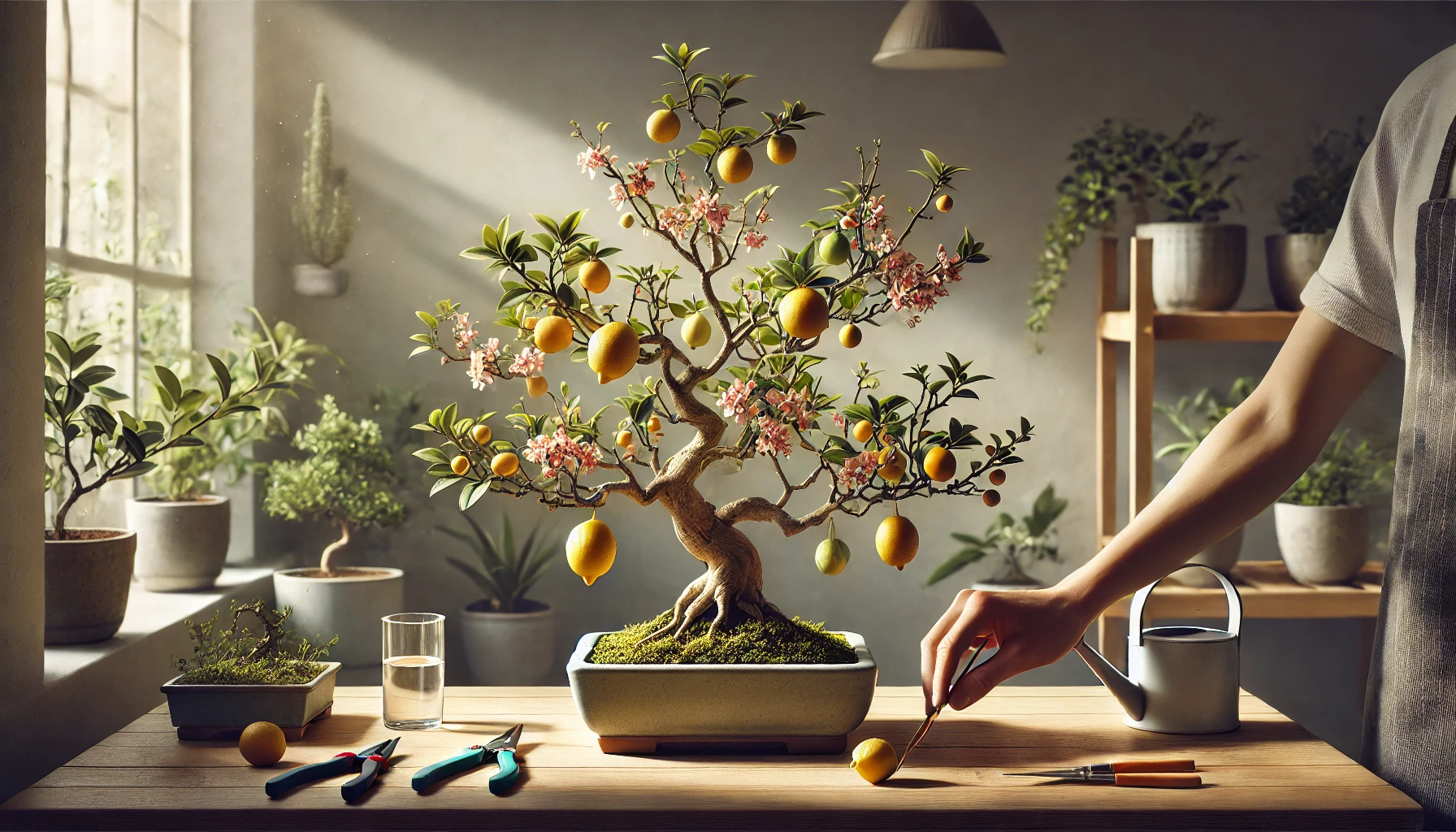Bonsai trees that produce flowers and fruits are among the most captivating to cultivate, blending aesthetic beauty with the wonder of nature’s productivity. However, encouraging your bonsai tree to flower and fruit requires specific care practices and techniques. In this guide, we’ll explore detailed methods to maximize flowering and fruiting potential, ensuring your bonsai thrives and becomes a showpiece in your collection.
Why Flowering and Fruiting Are Challenging for Bonsai
Bonsai trees grow in limited soil with restricted root systems, which can make flowering and fruiting more demanding compared to full-sized trees. Flower and fruit production consume significant energy, and improper care can lead to stunted growth or failure to bloom.
Challenges include:
- Insufficient nutrients.
- Lack of proper sunlight or watering.
- Stress from over-pruning or environmental changes.
By addressing these challenges, you can create conditions that encourage your bonsai to flourish.
Step 1: Choose the Right Species
Not all bonsai species are suitable for flowering and fruiting. Selecting a tree that naturally produces flowers or fruits simplifies the process.
Best Flowering and Fruiting Bonsai Species
- Citrus Trees (e.g., Lemon, Orange): Produces fragrant blossoms and vibrant fruits.
- Apple Trees (Malus spp.): Crabapples are ideal due to their small fruits and resilience.
- Pomegranate (Punica granatum): Known for its striking flowers and bright red fruits.
- Cherry Trees (Prunus spp.): Offers beautiful blossoms and ornamental cherries.
- Bougainvillea: A flowering species with vibrant, colorful bracts.
- Hibiscus: Produces large, eye-catching flowers.
Choose species suited to your climate and environment for the best results.
Step 2: Provide Adequate Sunlight
Flowering and fruiting bonsai trees require ample sunlight to produce energy for blooms and fruits. Place your bonsai in a location with 6–8 hours of direct sunlight daily.
Indoor Bonsai Tips
- Use grow lights to supplement natural light if your bonsai is indoors.
- Rotate the tree weekly to ensure even light distribution.
Outdoor Bonsai Tips
- Protect the tree from scorching midday sun in summer by providing partial shade.
- Ensure the tree is in a well-ventilated area for proper air circulation.
Step 3: Optimize Watering Practices
Watering directly impacts flowering and fruiting. Proper hydration supports nutrient uptake and overall health.
How to Water Effectively
- Keep the soil consistently moist but not waterlogged.
- Use well-draining bonsai soil to prevent root rot.
- Avoid wetting the leaves excessively, as this can lead to fungal diseases.
Adjusting Watering by Season
- Spring and Summer: Water frequently as the tree actively grows and flowers.
- Fall and Winter: Reduce watering as growth slows during dormancy.
Step 4: Use Fertilizers Strategically
Fruiting and flowering bonsai require specific nutrients to thrive. Fertilization is essential to replenish nutrients in the limited soil of a bonsai pot.
Essential Nutrients for Flowering and Fruiting
- Nitrogen (N): Supports leaf and stem growth but should be reduced during flowering.
- Phosphorus (P): Encourages flower and root development.
- Potassium (K): Enhances fruit production and overall plant health.
Fertilization Tips
- Use a balanced fertilizer during the growing season.
- Switch to a phosphorus-rich fertilizer when flower buds start to form.
- Apply fertilizers every 2–4 weeks during spring and summer.
Step 5: Master Pruning and Wiring
Pruning and wiring are essential for shaping the tree and promoting flowering and fruiting.
Structural Pruning
- Remove unnecessary branches to redirect energy to flowers and fruits.
- Focus on creating a balanced structure with well-spaced branches.
Maintenance Pruning
- Trim weak or overcrowded shoots to improve air circulation and light penetration.
Wiring Techniques
- Use bonsai wires to position branches for optimal sun exposure.
- Be gentle to avoid damaging flower buds or young fruits.
Step 6: Encourage Pollination
Pollination is crucial for fruit production. Without it, flowers may bloom but fail to set fruit.
Outdoor Bonsai
- Bees, butterflies, and other pollinators naturally assist with pollination.
Indoor Bonsai
- Use a small brush or cotton swab to manually transfer pollen between flowers.
- Ensure proper ventilation and humidity to support the process.
Step 7: Monitor Temperature and Humidity
Temperature and humidity levels significantly affect flowering and fruiting.
Ideal Conditions
- Temperature: Most flowering and fruiting bonsai prefer temperatures between 60–85°F (15–29°C). Protect them from extreme heat or frost.
- Humidity: Maintain moderate humidity levels by misting the leaves or using a humidity tray.
Step 8: Address Pests and Diseases
Pests and diseases can hinder flowering and fruiting by damaging buds, leaves, and roots.
Common Pests
- Aphids and Spider Mites: Remove with insecticidal soap or neem oil.
- Scale Insects: Scrape off gently and treat with horticultural oil.
Common Diseases
- Powdery Mildew: Treat with a baking soda spray or fungicide.
- Root Rot: Prevent by ensuring proper drainage and avoiding overwatering.
Step 9: Seasonal Care for Flowering and Fruiting
Tailor your care routine to the tree’s seasonal needs:
Spring
- Fertilize regularly to support new growth.
- Encourage flowering by maintaining consistent watering and sunlight.
Summer
- Protect fruits and flowers from scorching heat.
- Monitor watering to prevent dehydration.
Fall
- Gradually reduce watering and fertilization as growth slows.
- Prune lightly to prepare for dormancy.
Winter
- Protect the tree from frost or freezing temperatures.
- Avoid fertilizing, as the tree is dormant.
Troubleshooting Common Problems
Problem: No Flowers or Fruits
Causes:
- Lack of sunlight.
- Insufficient nutrients.
- Stress from improper pruning or environmental changes.
Solution:
- Adjust sunlight exposure and fertilization.
- Ensure the tree is healthy and unstressed.
Problem: Premature Flower or Fruit Drop
Causes:
- Overwatering or underwatering.
- Nutrient deficiencies.
- Pests damaging buds or fruits.
Solution:
- Water consistently and feed the tree with a balanced fertilizer.
- Treat pests immediately.
Conclusion: Patience Yields Beautiful Results
Encouraging your bonsai tree to flower and fruit is a rewarding endeavor that requires careful attention to its needs. By providing proper care, optimizing environmental conditions, and practicing patience, you can transform your bonsai into a vibrant masterpiece adorned with blossoms and fruits.

